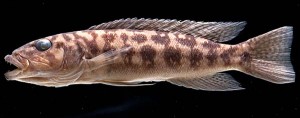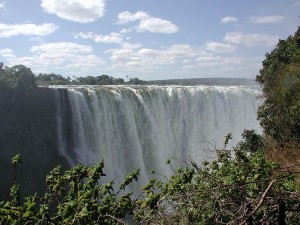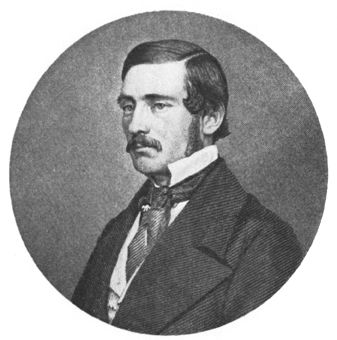Ex Africa semper aliquid novi, “From Africa always something new”, is a well-known expression, applied whenever something is discovered in Africa. It is usually attributed to Caius Plinius secundus (23-79), in his Natural History (Naturalis Historiæ).
In my copy of Plinius (1536-1538), the proverb is in Book VIII, chapter XVI, about lions, where he remarks on the diversity of animals in Africa: “Unde etia vulgare Græciæ dictum, Semper aliquid novi Africam affirre.” (Approximately: “Hence there is a common proverb in Greece, that there is certainly Always something new of Africa”). There are many printed editions of Plinius, and apparently variations in the divisions of the text and the exact wording. In the index of my copy one finds: Africa semper aliquid novi affert, i.e. Africa always brings something new. Personally, I prefer this variant above the others, both in Latin and English. In another edition Plinius is cited as: “unde etiam vulgare Græciæ dictum semper aliquid novi Africam adferre“. In an early translation the proverb is cited as “That Africke evermore bringeth forth some new and strange thing or other” (Holland, 1601). In a later translation (Bostock & Riley, 1855), Plinius is cited “Hence arose the saying, which was common in Greece even, that ‘Africa is always producing something new.'”
Since Africa wasn’t known by that name to the ancient Greek, and Plinius drew heavily from earlier authors, not least Aristoteles Stagirites (384-322 BCE), it may not be surprising that the proverb seems to come straight from the Greek and from Aristoteles’s Historia Animalium ( Περὶ Τὰ Ζῷα Ἱστορίαι), Book 8, part 28: Ἀɛὶ Λίβύη ϕέρɛί ṯί καίνόν. Thompson (1907) translates the relevant text as: “As a general rule, wild animals are at their wildest in Asia, at their boldest in Europe, and most diverse in form in Libya; in fact, there is an old saying, ‘Always something fresh in Libya.'” Aristoteles did not mean the present-day country of Libya, but Libya at the time should here be understood as northern Africa excluding Egypt.
When it comes to biodiversity we know better now, as tropical Asia and even more tropical South America are better places for searching animal diversity, but the world of Aristoteles and Plinius was essentially restricted to the Mediterranean and immediate neighbourhood. True, though, is that the assortment of large-sized vertebrates is much more conspicuous in Africa. And, certainly, new organisms are still being discovered also in Africa.
When I first became interested in fishes, African cichlids dominated the aquarium world. This was in the late 60s early 70s and I lived in a small town far away in the north of Sweden. With some other fanatics I imported Malawi cichlids from Germany and made occasional visits to Stockholm, capital of Sweden, to watch more expensive Tanganyika cichlids. Those are memories for some other time, but the consequence of the devotion was that I spent considerable time copying and deciphering the French in the monumental work of Poll (1956), Exploration Hydrobiologique du lac Tanganika. Poissons Cichlidae; and published some articles on African cichlids in Buntbarsche Bulletin as well as in the journal of the Nordic Cichlid Association (Nordiska ciklidsällskapet).Eventially, I shifted attention to South American cichlids, but in 1990 there was a golden opportunity to make a collection trip all over Zambia, targeting tilapias, but also preserving everything else with fins. Together with my friend Erkki Schwank, it was a long trip by car across the country, to Lakes Mweru, Mweru wantipa, Bangweulu, and Tanganyika. We didn’t stay long on the shores of Lake Tanganyika, but in a couple of days at Nsumbu we obtained a sizable collection of shore and deep water cichlids. Along with collections from an earlier trip by Gunnar Berglund to Kigoma, the Swedish Museum of Natural History now had a useful representation of Tanganyika cichlids, which was further added to by Tyson Roberts and Erkki, who stayed in Zambia.
Much later I was happy to meet underwater photographers and exporters Mikael and Magnus Karlsson who lived by and in the lake for many years and we teamed up to publish their observations on some of the lesser known species in Lake Tanganyika. The first paper is a description of a Lepidiolamprologus from the coast of Tanzania. Lepidiolamprologus includes a core number of species that are relatively elongate and marked by dark stripes or rows of blotches. Strong canine teeth emerging out of the lips and the somewhat oval pupil give them the look of a fierce predator. And predatory they are, and some definitely prey on babies of other cichlid species. These core species are L. elongatus, L. mimicus, L. kendalli, L. profundicola, and maybe L. nkambae. Lepidiolamprologus elongatus is distributed along the entire lake coastline, and L. profundicola may also be widespread. The remainder, and our new species, L. kamambae, are from the south of the lake. The status of L. nkambae and L. kendalli is uncertain, as no distinguishing characters are known. Lepidiolamprologus kendalli was described first, by Max Poll and Donald Stewart (1977), based on two specimens. They reported scales on the cheek and illustrated the holotype with a line drawing. Lepidiolamprologus nkambae was described by Wolfgang Staeck the following year, based on a single specimen from close to the type locality of L. kendalli. It was also illustraded with a line drawing. Staeck compared with the description of L. kendalli and concluded that they were different. Among distinguishing characters L. nkambae was said not have any scales on the cheek. Both names have since appeared in the aquarium literature but neither aquarists nor scientists have really been able to conclude about the validity of L. nkambae. Synonym of L. kendalli or distinct species? Only after our description of L. kamambae was I able to examine the holotype of L. nkambae and the paratype of L. kendalli. The L. nkambae specimen is very well preserved, and agrees with the description. The paratype of L. kendalli, on the other hand, is in a very poor state of preservation, something that was not mentioned in the original description. Scales are lost and the colour is washed out. I will not tell you my decision here on the validity of L. nkambae here, it will be something for a forthcoming paper, but I agree on one of the two alternative conclusions already presented ….
The material of L. kamambae that Mikael and Magnus had, is excellently preserved. Colours are fine, all scales are in place, the body is straight and the fins naturally spread, with no signs of decomposition anywhere, some mouths are a bit open but that makes counting teeth convenient. I like. Lepidiolamprologus kamambae shares most of its features with L. kendalli, in particular the beautiful contrasting light and dark markings on the top of the head, distinguishing the two from all other lamprologins. The body coloration, however, is very different. Lepidiolamprologus kamambae is more similar there to L. elongatus and L. mimicus, with rows of blotches along the back and flanks where L. kendalli instead has broad bands. One may guess that the blotch pattern is the plesiomorphic version in this group of fishes. There is probably not much more to say about this fish here, because the description is available as Open Access from Zootaxa.
Reflections may be in place, however. Lake Tanganyika is the oldest of the three Great Lakes of East Africa. More than 200 endemic cichlid species have been described from the lake, and estimates suggest a total of 300. Unlike in Lakes Malawi and Victoria, dominated almost exclusively by mouthbrooders of the ‘haplochromine’ group, the distantly related lamprologins, of several genera, all substrate brooders, are a large unit in Lake Tanganyika, with over 70 valid species known so far. Several recent studies have investigated their phylogenetic relationships, and relations to the half dozen species of Lamprologus that only occur in the fluviatile environment of the Congo River (e.g., Schelly et al. 2006). The latter are obviously a group on their own, but within-lake relationships still offer much to be investigated. I am curious how things will develop, and it is interesting to work with fishes offering this kind of perspective. When it comes to African cichlids, in particular those of the Great Lakes, systematics has investigated them from many different angles, but still is way off from a coherent and credible evolutionary history. There are papers on dried out lakes, explosive radiation, lake level fluctuations, depth segregation, sympatric speciation, not to mention hybridisation. Academic analyses are enough to fill volumes, and it is engaging and important that this unique fauna, evolutionary hotspots with dense concentrations of phylogenetically close, but morphologically often far apart species, will continue to receive attention. Even so, and connecting back to Plinius and friends, the following passage, from the chapter of the famous proverb seem like they may be pertinent, and of course inspired by Aristoteles, in light of some of the ideas about African cichlid evolution, or perhaps not ideas but frustration, read cichlid for lion:
The noble appearance of the lion is more especially to be seen in that species which has the neck and shoulders covered with a mane, which is always acquired at the proper age by those produced from a lion; while, on the other hand, those that are the offspring of the pard, are always without this distinction. The female also has no mane. The sexual passions of these animals are very violent, and render the male quite furious. This is especially the case in Africa, where, in consequence of the great scarcity of water, the wild beasts assemble in great numbers on the banks of a few rivers. This is also the reason why so many curious varieties of animals are produced there, the males and females of various species coupling promiscuously with each other.3 Hence arose the saying, which was common in Greece even, that “Africa is always producing something new.” (Plinius, Naturalis Historiae; translation by Bostock & Riley, 1855)
From this we obviously learn that at any point in time we shall know less than at a later time (especially if we don’t investigate the facts ourselves), and that everything has been thought of before.
References
Bostock, J., & H. T. Riley (eds.) 1855, Pliny the Elder, The Natural History. Taylor & Francis, London.
Holland, P. (translator), 1601. The Historie of the world. Commonly called, The Naturall Historie of C. Plinius secundus. London.
Kullander, S. O., M. Karlsson & M. Karlsson. 2012. Lepidiolamprologus kamambae, a new species of cichlid fish (Teleostei: Cichlidae) from Lake Tanganyika. Zootaxa, 3492: 30-48. Open Access PDF from Zootaxa
Kullander, S. O. & T. R. Roberts. 2011. Out of Lake Tanganyika: endemic lake fishes inhabit rapids of the Lukuga River. Ichthyological Exploration of Freshwaters, 22: 355-376. Open Access PDF
Plinius Secundus, C. 1536-1538. Naturalis Historiae. Aldus, Venetia.
Poll, M. 1956. Poissons Cichlidae . Exploration Hydrobiologique du Lac Tanganika (1946-1947). Résultats scientifiques, III (5B): 1-619.
Poll, M. & D. J. Stewart. 1977. Un nouveau Lamprologus du sud du Lac Tanganika (Zambia). Revue de Zoologie africaine, 91: 1047-1056.
Schelly, R., W. Salzburger, S. Koblmüller, N. Duftner and C. Sturmbauer. 2006. Phylogenetic relationships of the lamprologine cichlid genus Lepidiolamprologus (Teleostei: Perciformes) based on mitochondrial and nuclear sequences, suggesting introgressive hybridization. Molecular Phylogenetics and Evolution, 38: 426-438.
Staeck, W. 1978. Ein neuer Cichlideaus dem südlichen Tanganjikasee: Lamprologus nkambae n. sp. (Pisces, Cichlidae). Revue de Zoologie africaine, 92: 436-441.
Thompson, D. W (translator). 1907. The history of animals. John Bell, London.



